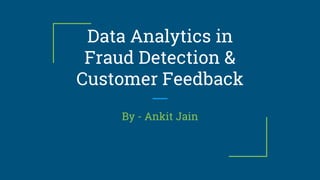Data analytics in fraud detection and customer feedback
- 1. Data Analytics in Fraud Detection & Customer Feedback By - Ankit Jain
- 2. Types of Ecommerce Frauds â—Ź Buyer Fraud â—‹ Credit Card Fraud â—‹ Reseller Fraud â—‹ COD/RTO Fraud â—‹ Product Exchange Fraud â—Ź Seller Fraud â—‹ Reviews/Ratings Fraud
- 3. Identifying Fraud Buyers â—Ź Preempting a fraud transaction is key to success for an ecommerce business â—Ź There are several ways in operations to detect frauds like â—‹ Two factor authentication for credit card frauds â—‹ Address parsing for COD/RTO frauds Inspite of all this, machine learning can prove extremely
- 4. Labelled Data Generation â—Ź Labelled Data is food for supervised learning problems. â—Ź Generally human raters are employed to generate a labelled data set. â—Ź Platforms such as Amazon Mechanical turks are used in this case.
- 5. Feature Generation â—Ź For each human rated transaction, we generate features which might be a good predictor of whether that transaction is fraudulent or not â—Ź Some examples of features are : â—‹ Buyer Rating â—‹ # Credit Cards used by buyer â—‹ # previous fraudulent purchases by buyer
- 6. Machine Learning â—Ź Once you have labelled data and features, we can use classification techniques like Logistic Regression, Random Forests to detect fraudulent users. â—Ź Issues: â—‹ Imbalanced Datasets â—‹ Evaluation Metric: Depends on application
- 7. Human in the loop approach â—Ź As a result of machine learning, humans are not eliminated but their job is reduced. 0 0.3 0.7 1 Human Evaluation Definitely FraudDefinitely Legitimate Fraud Probability
- 8. Customer Feedback â—Ź Customer Service is one of the integral part of customer experience for ecommerce companies. A good customer service contributes to the brand value of the company. â—Ź Serves two purposes: â—‹ Address customer grievances â—‹ Serve as feedback loop for the product
- 9. Metrics on Customer Feedback â—Ź Explicit â—‹ Net Promoter Score â– Promoters : People rating the product 9 and 10 â– Detractors: People rating the product 6 or below â– Passives: People rating the product 7 or 8 â– NPS above 0 are considered decent and above 30-40 are considered great
- 10. Data Analytics on Feedbacks â—Ź While giving feedback, a customer writes lot of stuff in feedback form. â—Ź Natural Language Processing (NLP) can be used to identify the sentiment of reviews and understand the frequent pain points of the customers
- 11. Bag of Words Model â—Ź This model can be used to identify classify the reviews into positive and negative using supervised classification techniques â—Ź Again, the first step here is to generate labelled data using human raters â—Ź Removal of english stop words from the reviews â—Ź Filtering out only the adjectives which might correspond to positive or negative words. â—Ź Construct a feature saying whether a particular adjective appears in the review or not
- 12. THANK YOU












